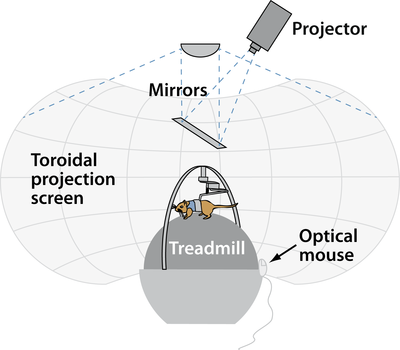Rodent Virtual Reality
|
The centerpiece in the rodent virtual reality is a modified Kramer-sphere, which allows the animal to move while keeping its actual position constant. The animal is positioned on the sphere with the help of a custom-made harness that leaves head and legs freely movable. Forward and backward movements of the animal induce rotations of the sphere similar to a treadmill. The speed and direction of the rodent’s locomotion are registered by two sensors (conventional optical USB computer mice) and fed into the computer that generates the visual VR. The visual presentation of the virtual environment in the rodent VR is done via projection onto a spherical canvas enclosing the Kramer-sphere. The fixed positioning of the rodent while navigating the virtual environment allows simultaneous electrophysiological recording while the animals perform behavioral and/or psychophysical tasks. Contact |
|
|
|
Figure: Overview of the rodent virtual realtity setup |
Bernstein projects that used the Rodent VR setup
- Project A3 – New methods to study visual influences on auditory processing. Benedikt Grothe (LMU), Andreas Herz (LMU), Christian Leibold (LMU), and Harald Luksch (TUM)
- Project B-T6 - Influence of sensory conditions on the hippocampal population code for space. Kay Thurley (LMU), Christian Leibold (LMU), Anton Sirota (LMU)
Publications
Thurley K and Ayaz A (2016) Virtual reality systems for rodents. Current Zoology
Kautzky M and Thurley K (2016) Estimation of self-motion duration and distance in rodents. R. Soc. open sci. 3: 160118.
Garbers C; Henke J; Leibold C; Wachtler T; Thurley K (2015) Contextual processing of brightness and color in Mongolian gerbils. Journal of Vision (2015) 15:1 pii: 13. doi: 10.1167/15.1.13
Thurley K; Henke J; Hermann J; Ludwig B; Tatarau C; Wätzig A; Herz A; Grothe B; Leibold C (2014) Mongolian gerbils learn to navigate in complex virtual spaces. Behav Brain Res (2014) 266: 161-168


